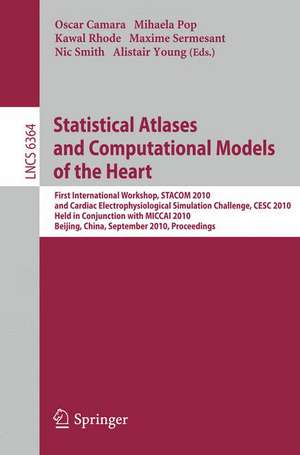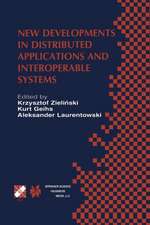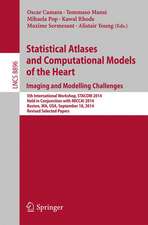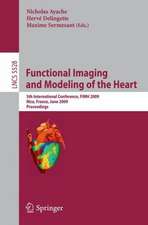Statistical Atlases and Computational Models of the Heart: First International Workshop, STACOM 2010, and Cardiac Electrophysical Simulation Challenge, CESC 2010, Held in Conjunction with MICCAI 2010, Beijing, China, September 20, 2010, Proceedings: Lecture Notes in Computer Science, cartea 6364
Editat de Oscar Camara, Mihaela Pop, Kawal Rhode, Maxime Sermesant, Nic Smith, Alistair Youngen Limba Engleză Paperback – 3 sep 2010
Din seria Lecture Notes in Computer Science
- 20%
 Preț: 1061.55 lei
Preț: 1061.55 lei - 20%
 Preț: 307.71 lei
Preț: 307.71 lei - 20%
 Preț: 438.69 lei
Preț: 438.69 lei - 20%
 Preț: 645.28 lei
Preț: 645.28 lei -
 Preț: 410.88 lei
Preț: 410.88 lei - 15%
 Preț: 580.46 lei
Preț: 580.46 lei - 17%
 Preț: 427.22 lei
Preț: 427.22 lei - 20%
 Preț: 596.46 lei
Preț: 596.46 lei -
 Preț: 381.21 lei
Preț: 381.21 lei - 20%
 Preț: 353.50 lei
Preț: 353.50 lei - 20%
 Preț: 1414.79 lei
Preț: 1414.79 lei - 20%
 Preț: 309.90 lei
Preț: 309.90 lei - 20%
 Preț: 583.40 lei
Preț: 583.40 lei - 20%
 Preț: 1075.26 lei
Preț: 1075.26 lei - 20%
 Preț: 310.26 lei
Preț: 310.26 lei - 20%
 Preț: 655.02 lei
Preț: 655.02 lei - 20%
 Preț: 580.93 lei
Preț: 580.93 lei - 20%
 Preț: 340.32 lei
Preț: 340.32 lei - 15%
 Preț: 438.59 lei
Preț: 438.59 lei - 20%
 Preț: 591.51 lei
Preț: 591.51 lei - 20%
 Preț: 649.49 lei
Preț: 649.49 lei - 20%
 Preț: 337.00 lei
Preț: 337.00 lei -
 Preț: 449.57 lei
Preț: 449.57 lei - 20%
 Preț: 607.39 lei
Preț: 607.39 lei - 20%
 Preț: 1024.44 lei
Preț: 1024.44 lei - 20%
 Preț: 579.30 lei
Preț: 579.30 lei - 20%
 Preț: 763.23 lei
Preț: 763.23 lei - 20%
 Preț: 453.32 lei
Preț: 453.32 lei - 20%
 Preț: 575.48 lei
Preț: 575.48 lei - 20%
 Preț: 585.88 lei
Preț: 585.88 lei - 20%
 Preț: 825.93 lei
Preț: 825.93 lei - 20%
 Preț: 763.23 lei
Preț: 763.23 lei - 17%
 Preț: 360.19 lei
Preț: 360.19 lei - 20%
 Preț: 1183.14 lei
Preț: 1183.14 lei - 20%
 Preț: 340.32 lei
Preț: 340.32 lei - 20%
 Preț: 504.57 lei
Preț: 504.57 lei - 20%
 Preț: 369.12 lei
Preț: 369.12 lei - 20%
 Preț: 583.40 lei
Preț: 583.40 lei - 20%
 Preț: 343.62 lei
Preț: 343.62 lei - 20%
 Preț: 350.21 lei
Preț: 350.21 lei - 20%
 Preț: 764.89 lei
Preț: 764.89 lei - 20%
 Preț: 583.40 lei
Preț: 583.40 lei -
 Preț: 389.48 lei
Preț: 389.48 lei - 20%
 Preț: 341.95 lei
Preț: 341.95 lei - 20%
 Preț: 238.01 lei
Preț: 238.01 lei - 20%
 Preț: 538.29 lei
Preț: 538.29 lei
Preț: 333.72 lei
Preț vechi: 417.15 lei
-20% Nou
Puncte Express: 501
Preț estimativ în valută:
63.86€ • 66.84$ • 53.15£
63.86€ • 66.84$ • 53.15£
Carte disponibilă
Livrare economică 10-24 martie
Preluare comenzi: 021 569.72.76
Specificații
ISBN-13: 9783642158346
ISBN-10: 364215834X
Pagini: 292
Ilustrații: XII, 292 p. 140 illus.
Greutate: 0.45 kg
Ediția:2010
Editura: Springer Berlin, Heidelberg
Colecția Springer
Seriile Lecture Notes in Computer Science, Image Processing, Computer Vision, Pattern Recognition, and Graphics
Locul publicării:Berlin, Heidelberg, Germany
ISBN-10: 364215834X
Pagini: 292
Ilustrații: XII, 292 p. 140 illus.
Greutate: 0.45 kg
Ediția:2010
Editura: Springer Berlin, Heidelberg
Colecția Springer
Seriile Lecture Notes in Computer Science, Image Processing, Computer Vision, Pattern Recognition, and Graphics
Locul publicării:Berlin, Heidelberg, Germany
Public țintă
ResearchCuprins
Keynote Presentations.- Atlas Construction and Image Analysis Using Statistical Cardiac Models.- Patient-Specific Modeling of the Heart: Applications to Cardiovascular Disease Management.- The Generation of Patient-Specific Heart Models for Diagnosis and Interventions.- Methods and Infrastructure for Atlas Construction.- The Cardiac Atlas Project: Rationale, Design and Procedures.- The Cardiac Atlas Project: Preliminary Description of Heart Shape in Patients with Myocardial Infarction.- The Cardiac Atlas Project: Development of a Framework Integrating Cardiac Images and Models.- Atlas-Based Quantification of Myocardial Motion Abnormalities: Added-value for the Understanding of CRT Outcome?.- Towards High-Resolution Cardiac Atlases: Ventricular Anatomy Descriptors for a Standardized Reference Frame.- Structure and Flow.- Robust Atlas-Based Segmentation of Highly Variable Anatomy: Left Atrium Segmentation.- Atlas-Based Reduced Models of Blood Flows for Fast Patient-Specific Simulations.- Image and Physiological Data Fusion for Guidance and Modelling of Cardiac Resynchronization Therapy Procedures.- A Multi-method Approach towards Understanding the Pathophysiology of Aortic Dissections – The Complementary Role of In-Silico, In-Vitro and In-Vivo Information.- Endowing Canonical Geometries to Cardiac Structures.- Automatic Segmentation of Left Atrial Geometry from Contrast-Enhanced Magnetic Resonance Images Using a Probabilistic Atlas.- Interactive Cardiac Image Analysis for Biventricular Function of the Human Heart.- Cardiac Motion Estimation Using a ProActive Deformable Model: Evaluation and Sensitivity Analysis.- Investigating Heart Failure Using Ventricular Imaging and Modelling.- Incorporating Low-Level Constraints for the Retrieval of Personalised Heart Models fromDynamic MRI.- Volumetric Myocardial Mechanics from 3D+t Ultrasound Data with Multi-model Tracking.- Mechanics and Motion.- Cardiac Active Contraction Parameters Estimated from Magnetic Resonance Imaging.- Electrophysiology and Electrical Activation.- Recovering Cardiac Electrical Activity from Medical Image Sequence: A Model-Based Approach.- Non-invasive Activation Times Estimation Using 3D Echocardiography.- Modeling Drug Effects on Personalized 3D Models of the Heart: A Simulation Study.- How Much Geometrical Detail Do We Need in Cardiac Electrophysiological Imaging? A Generic Heart-Torso Representation for Fast Subject-Specific Customization.- Influence of Geometric Variations on LV Activation Times: A Study on an Atlas-Based Virtual Population.- Computational Electrophysiological Simulation Challenge (CESC 2010).- Generic Conduction Parameters for Predicting Activation Waves in Customised Cardiac Electrophysiology Models.- A Statistical Physiological-Model-Constrained Framework for Computational Imaging of Subject-Specific Volumetric Cardiac Electrophysiology Using Optical Imaging and MRI Data.- Estimation of Reaction, Diffusion and Restitution Parameters for a 3D Myocardial Model Using Optical Mapping and MRI.- Personalization of Fast Conduction Purkinje System in Eikonal-Based Electrophysiological Models with Optical Mapping Data.
Caracteristici
State-of-the-art research Fast-track conference proceedings Unique visibility


















